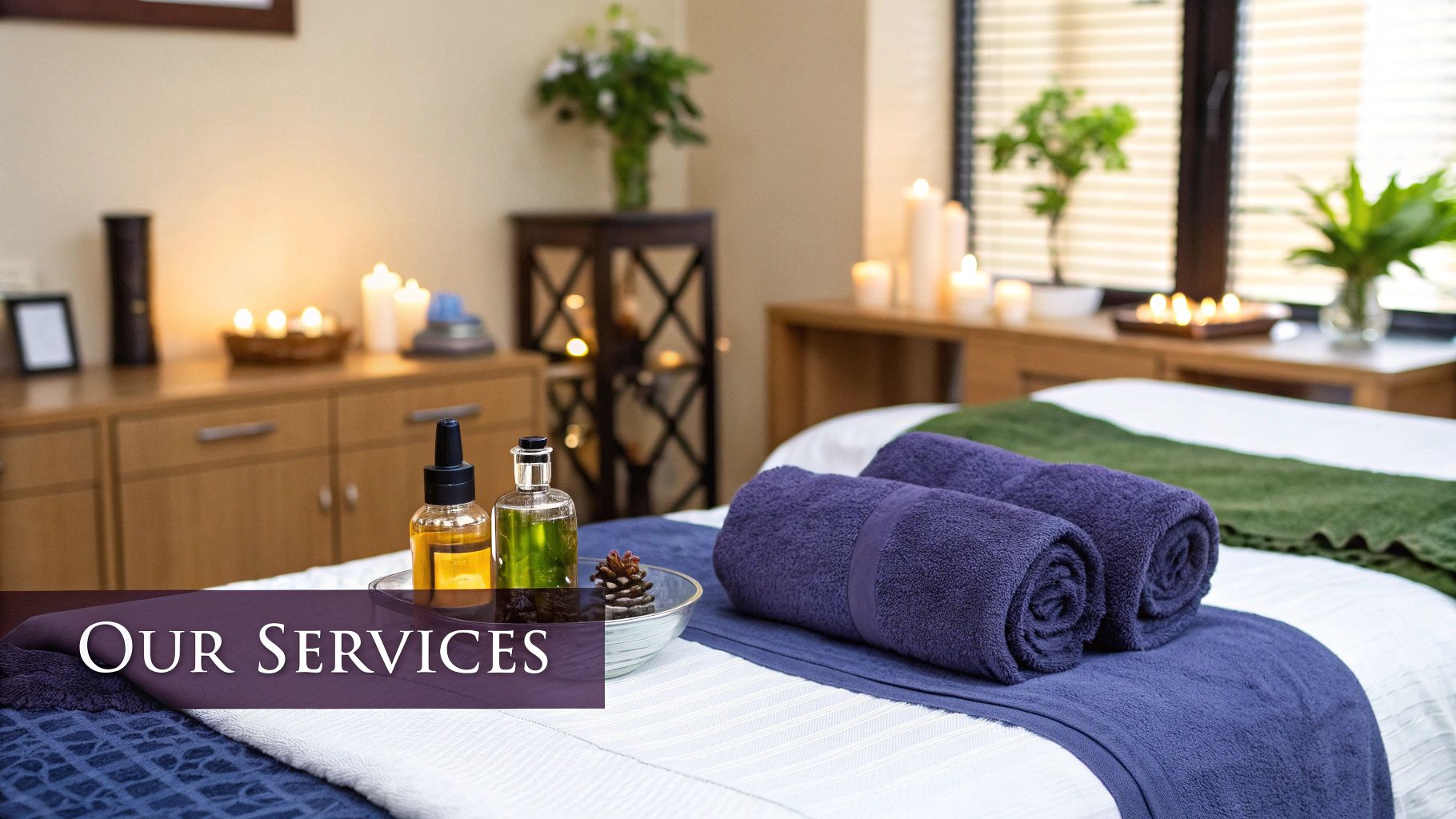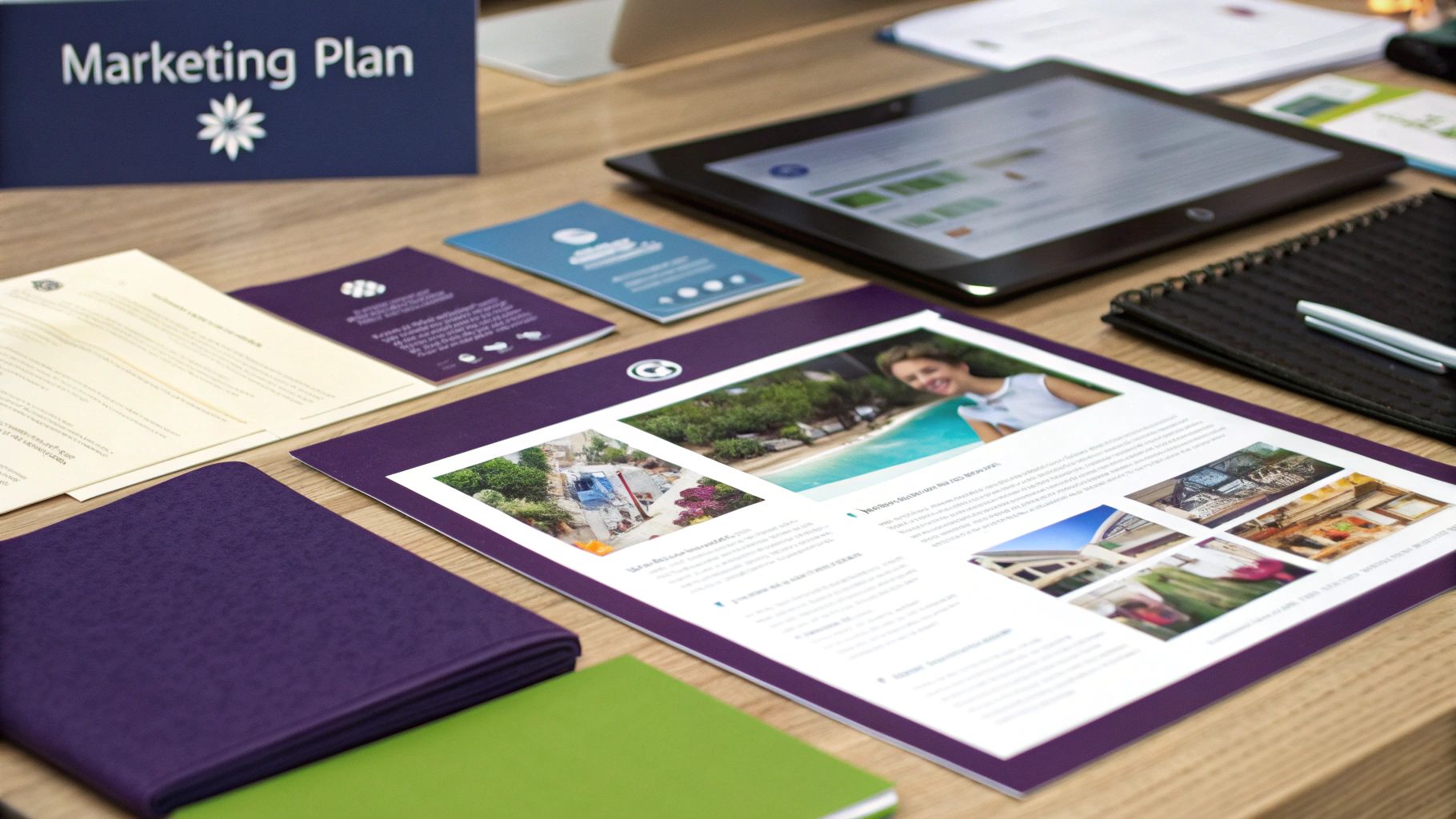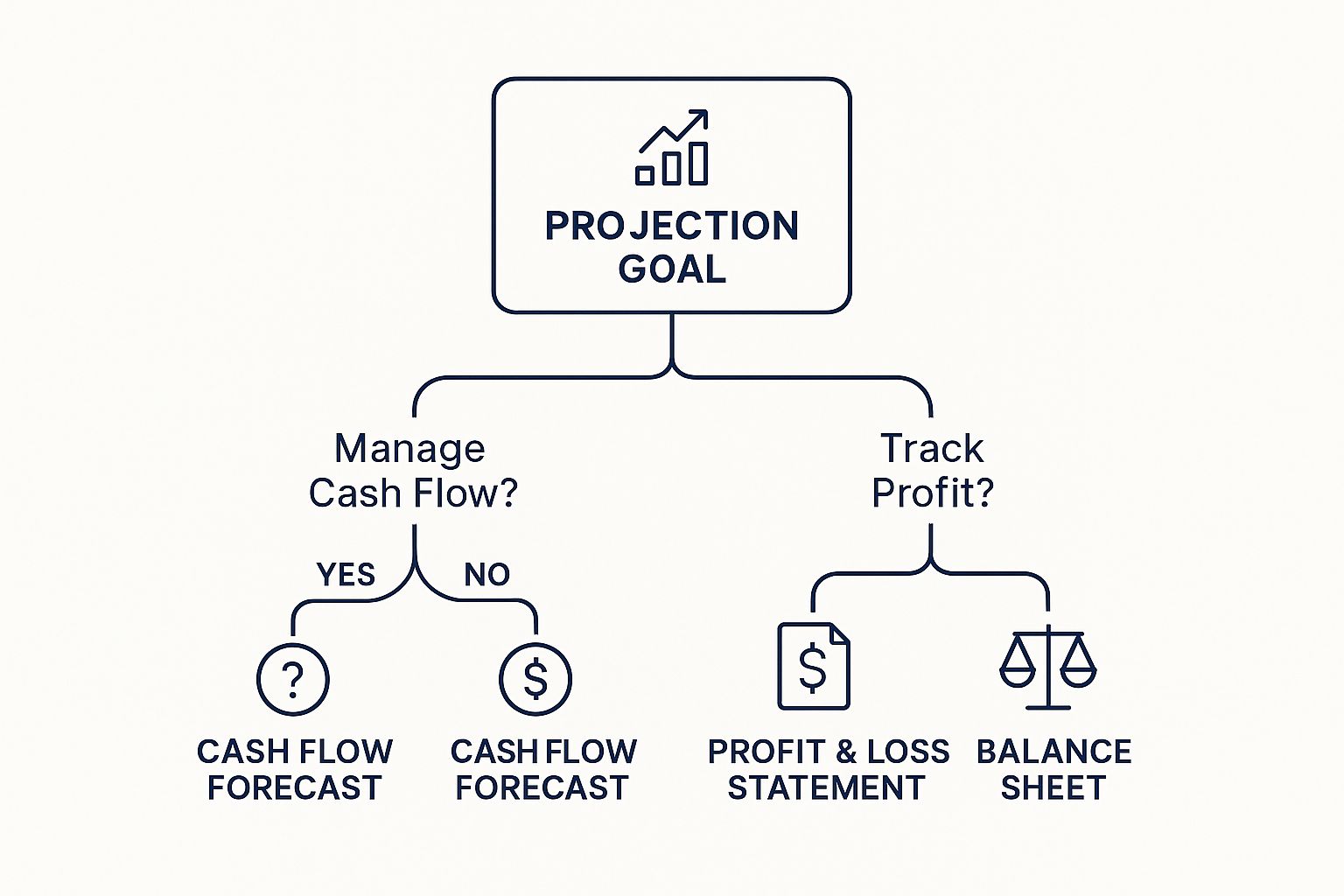Your Actionable Spa Business Plan Template for Success

Think of your spa business plan template as more than just a formal document for bankers. It's your strategic roadmap, the very soul of your business captured on paper. It forces you to get real about every detail, from your brand's vibe to your financial projections, turning that beautiful spa dream into a business that can actually thrive.
Building Your Spa's Vision and Executive Summary

Before a single client steps inside, your spa needs to exist as a crystal-clear, compelling idea. This first part of your business plan—the vision and executive summary—is where you bring that idea to life. It’s the first thing anyone will read, so it needs to pack a punch and make an unforgettable first impression.
This isn’t about scribbling down a generic mission statement. Your task here is to forge a distinct identity that will guide every single decision you make, from the scent wafting from your diffusers to the voice of your marketing campaigns. It's the core of your brand.
Defining Your Spa's Core Identity
First, you need to decide: What kind of spa are you creating? This is the big question. Your answer shapes everything—your ideal client, your service menu, your brand personality. Resist the urge to be everything to everyone. In the spa world, specialization is your superpower.
To get started, consider these common spa concepts and choose the one that fits your vision:
- The Urban Retreat: Picture a serene escape tucked into a busy city. Your action plan is to offer quick, effective treatments like express facials and tension-melting massages for professionals on the go.
- The Holistic Wellness Center: This model focuses on the mind-body connection. Your actionable step is to build a menu with services like aromatherapy, acupuncture, and meditation classes right alongside traditional spa treatments.
- The High-Tech Medi-Spa: Here, you blend pure relaxation with clinical results. You'll need to offer advanced treatments like laser hair removal, chemical peels, and injectables, all under medical supervision.
- The Destination Day Spa: This is about creating an immersive, all-day experience. Your goal is to sell a total escape with luxurious amenities and decadent treatment packages.
Choosing your path is the critical first step. For a deeper look at these initial stages, our guide on how to start a spa business walks you through the entire process, from concept to grand opening. It’s a great resource to help you nail down your core concept before you start writing.
Crafting a Powerful Executive Summary
Once you have a clear vision, it’s time to boil it down into an executive summary. This is the most important page in your entire spa business plan. It’s a short, high-level overview of everything that follows, designed to grab the reader’s attention and convince them your spa is a brilliant idea worth investing in.
An effective executive summary isn't just a table of contents; it's the highlight reel. It should tell a compelling story about your business in under two pages, making the reader eager to learn more.
Here’s an actionable tip: write your executive summary last, after you’ve hammered out all the other sections. That way, you can pull the most powerful highlights from each part. But remember, it always sits at the very beginning of your final document.
To create a persuasive summary, make sure you include these key elements:
- Your Mission: Write a punchy one or two-sentence statement that captures your spa’s purpose. What experience are you promising?
- Company & Concept: Briefly introduce your spa. What's its name, where is it, and what’s the unique concept? (e.g., "Serenity Now is a holistic wellness center in downtown Austin…").
- Services Offered: List your main service categories. No need to detail every single treatment, just give a feel for your menu (e.g., "…specializing in therapeutic massage, organic facials, and mindfulness workshops.").
- Target Market: Define your ideal client. Get specific. (e.g., "We're targeting health-conscious millennials and working professionals aged 25-45.").
- Competitive Advantage: State what makes you different. Why should clients choose you over the spa down the street? This could be a unique service, a killer customer experience, or a focus on an underserved niche.
- Financial Highlights: Show you've crunched the numbers. Provide key figures like your total startup funding request, projected first-year revenue, and when you expect to hit profitability.
Get to Know Your Market and Size Up the Competition
A successful spa isn't just built on good vibes and plush robes. Before you name your spa or pick out skincare lines, you have to do your homework. This analysis is where your spa business plan template goes from a simple document to a strategic weapon, helping you make smart, data-driven decisions instead of just guessing.
The good news? You're entering a booming industry. The U.S. spa market has been on a tear, growing by 5.8% to a whopping $22.5 billion in revenue. Spa visits are also up 3.1%, hitting 187 million. This tells us one thing loud and clear: people are hungry for wellness, and they’re willing to pay for it.
Pinpoint Your Dream Client
First, you must identify who you are trying to attract. Trying to market to "everyone" is a surefire way to connect with no one. The key is to get laser-focused on your target clientele. An ideal customer profile template is a great tool for this, helping you sketch out a detailed picture of your perfect customer.
Go beyond just age and income. To make this actionable, answer these questions about their lifestyle—their psychographics:
- What's their lifestyle like? Are they stressed-out professionals who need a quick 30-minute facial on their lunch break? Or are they new moms desperate for a few hours of quiet pampering?
- What do they value? Do they prioritize organic, sustainable products and holistic practices? Or are they chasing results with the latest high-tech treatments?
- How do they spend their money? Are they hunting for a great deal, or are they ready to splurge on a premium, all-inclusive experience?
For instance, a spa targeting "wellness-obsessed millennials" would build its brand with holistic treatments, vegan skincare, and an Instagram feed full of user-generated content. On the flip side, a spa for "affluent empty-nesters" should focus its efforts on advanced anti-aging services, ultimate comfort, and more traditional marketing like local magazine ads.
Do Some Serious Competitive Spying
Knowing your competition means more than just Googling other spas in your area. You need to become a bit of a detective. Your mission is to figure out what they do well and, more importantly, where they’re dropping the ball. That's where you'll find your opening.
Your real goal here is to spot a gap in the market—a need that isn't being met—that your spa is uniquely positioned to fill. Don't just browse their websites. For real insight, book a service and experience them firsthand.
A proper competitive analysis isn't about copying what others are doing. It’s about finding what they aren't doing and then doing it better than anyone else. This is how you create a compelling reason for clients to choose you.
To make this actionable, create a simple spreadsheet to organize your intel. For each major competitor, investigate these key areas:
| Competitive Factor | What to Look For | Example Insight |
|---|---|---|
| Service Menu | What are their most popular treatments? Do they offer anything unique, like infrared saunas or sound baths? | "Competitor A has a huge massage menu but only offers two basic facials. Huge opportunity for advanced skincare." |
| Pricing Strategy | Are they a budget, mid-range, or luxury spot? Do they push packages or memberships? | "Competitor B's prices are about 15% higher for similar services. We could offer a more premium experience at a slightly more accessible price point." |
| Client Experience | Dig into their online reviews on Google and Yelp. What do people rave about? What are the common complaints? | "Reviews for Competitor C constantly mention the checkout feels rushed and impersonal. We can make our checkout a seamless, relaxing part of the experience." |
| Marketing & Vibe | How are they getting the word out? Are they all over social media, running local ads, or partnering with other businesses? | "Competitor A has terrible local SEO. They don't even show up for 'spa near me' searches. We can dominate that." |
After digging in, you might discover that no one in your town is specifically catering to men, or that there's a huge demand for prenatal massages with no one specializing in it. This kind of intelligence is gold. It’s what transforms a generic spa idea into a targeted business that people are genuinely excited about.
Designing Your Service Menu and Operations Plan

This is where your vision really starts to take shape. Your service menu is the heart of your spa—it's what draws clients in. The operations plan? That's the backbone holding everything together, making sure every visit is seamless. This part of your spa business plan template is all about turning your brand identity into profitable, real-world offerings.
Your menu should be a direct reflection of your spa concept. A high-tech medi-spa will have a completely different lineup than a holistic wellness retreat. Your task is to create a focused selection of services that clearly represents your brand, not a little bit of everything.
Crafting a Compelling and Profitable Service Menu
Think of your service menu as one of your most powerful marketing tools. It must be enticing, easy for clients to navigate, and priced strategically to boost both your revenue and your clients' sense of value. Your first action is to nail down a core group of services that perfectly align with your brand and the clients you want to attract.
Organize your offerings into clear, intuitive categories. For instance:
- Signature Experiences: These are the unique, multi-step treatments that become your spa's calling card and justify a premium price tag.
- Facial Therapies: Group facials by skin concern, like anti-aging, acne-prone, or deep hydration, to make it easy for clients to find what they need.
- Body Treatments: This is your home for massages, luxurious body wraps, exfoliating scrubs, and other hands-on therapies.
- Express Services: Target the on-the-go client with treatments under 45 minutes that work great for lunch breaks or as an easy add-on to another service.
Here’s a sample structure to guide you. Notice the tiered pricing and how descriptions help sell the experience.
Sample Spa Service Menu and Pricing Structure
| Service Category | Service Name | Description | Duration (minutes) | Price ($) |
|---|---|---|---|---|
| Signature Experiences | The Urban Escape | A full-body exfoliation followed by a detoxifying mud wrap and a 60-minute aromatherapy massage. | 120 | 250 |
| Facial Therapies | Glow & Go Express Facial | A quick pick-me-up facial including a deep cleanse, exfoliation, and targeted hydration mask. | 30 | 75 |
| Facial Therapies | Age-Defy Radiance Facial | Advanced treatment using peptides and antioxidants to combat fine lines and restore youthful vitality. | 75 | 165 |
| Body Treatments | Deep Tissue Massage | A therapeutic massage targeting chronic muscle tension and knots for deep relief. | 60 | 130 |
| Body Treatments | Sea Salt Body Glow | An invigorating full-body scrub with mineral-rich sea salts to soften and smooth the skin. | 45 | 95 |
| Add-Ons | Aromatherapy Boost | Enhance any massage or facial with a choice of calming, energizing, or clarifying essential oil blends. | N/A | 20 |
Use this table as a starting point. Tailor it to your brand, calculate your costs, and create packages that encourage clients to explore more of what you offer.
Pricing is absolutely critical. Research your competitors, but don't just mimic their price list. You must calculate the true cost of every service—factoring in product used per treatment, your therapist’s time, and a share of your overhead. Your prices should communicate the quality of your products, the skill of your staff, and the luxurious environment you’ve created.
To make your pricing strategy actionable, create profitable packages and memberships. Bundling three complementary services into a "Rejuvenation Package" for a slight discount not only increases the average ticket price but also encourages clients to experience more of what you offer.
The global spa market is booming, thanks to a huge consumer shift toward wellness and self-care. It jumped from $72.32 billion to an estimated $80.67 billion in just one year—a growth rate of 11.5%! That momentum is set to continue, with projections showing the market will hit $124.11 billion soon. Clients are actively looking for quality spa experiences, creating a massive opportunity. You can dive deeper into these trends by checking out the full report from The Business Research Company.
Building Your Operational Blueprint
Your operations plan is the engine humming quietly in the background, making sure your spa runs like a dream. It covers every touchpoint, from booking to checkout. A detailed plan is your best defense against chaos and inconsistency.
Start by mapping out a typical day. Write down opening procedures, mid-day routines, and a closing checklist. This ensures everyone on your team knows exactly what their role is, with no guesswork.
Next, create a staffing plan. Based on your service menu and projected traffic, determine how many therapists, front desk coordinators, and support staff you'll need. Write crystal-clear job descriptions and find the right mix of full-time and part-time staff to manage labor costs without being short-handed.
Finally, pick the right tools for the job. Implement a solid system for inventory management for both professional and retail products to avoid running out of essentials. Most importantly, invest in quality spa management software. A modern platform like Fresha or Vagaro will handle online booking, client history, staff schedules, and payments, freeing you from administrative headaches so you can focus on the client experience.
Crafting Your Marketing Plan to Keep Your Spa Booked Solid

Let's be real: you can have the most luxurious spa, but if no one knows you exist, your appointment book will stay empty. A brilliant marketing and client acquisition plan is the engine that drives your business forward, attracting new faces and keeping regulars coming back.
This section of your spa business plan template is where you'll map out exactly how to get noticed. The goal isn't to spend a fortune, but to create a smart, multi-channel strategy that connects with your ideal clients.
Winning Online: Mastering Your Digital First Impression
For most potential clients, the journey to your spa starts with a Google search. Your digital presence is as critical as your physical one, so making a stellar first impression online is non-negotiable.
Your first action is to dominate local SEO (Search Engine Optimization). When someone types "spa near me" or "best facial in [Your City]," you absolutely have to show up. Start by creating a fully built-out Google Business Profile, complete with stunning photos of your space, your full service menu, and a system for gathering a steady stream of glowing reviews.
Social media is your other digital superpower. It’s for building a community. For actionable steps, check out our guide on social media marketing for beauty salons, which is loaded with practical tips. Use platforms like Instagram and Facebook to show off your spa's unique atmosphere, run contests, and share rave reviews from happy clients.
Your marketing shouldn't just sell—it should educate. To implement this, position yourself as the go-to expert by sharing content on skincare benefits, stress-relief tips, or the science behind your treatments. When you build trust, clients will see you as a wellness partner.
Creating Local Buzz and Unbreakable Loyalty
While a strong digital game is essential, don't forget the magic of real-world connections. Offline strategies build deep roots in your community and generate word-of-mouth buzz.
A great first step is to form partnerships with complementary local businesses. Reach out to boutique hotels, high-end bridal shops, or corporate wellness programs. You can create exclusive packages or offer referral discounts that benefit both of you and introduce your spa to a perfectly matched audience.
Here are a few powerful offline tactics to build into your plan:
- Host Wellness Workshops: Open your doors for small events like a "Skincare 101" class or a "Mindful Meditation" evening. It’s a pressure-free way for potential clients to experience your space and expertise.
- Launch a Killer Referral Program: Reward your happiest clients for spreading the love. An actionable offer is a 15% discount on their next service for every new client they refer.
- Create a Must-Have Loyalty Program: Make regulars feel like VIPs. A simple points system (e.g., one point per dollar spent) that unlocks free services or product discounts is fantastic for encouraging repeat business.
Remember, keeping a client is far more profitable than constantly chasing new ones. Learning effective strategies to boost customer retention is vital for sustainable success and a consistently full appointment book.
The timing to build this engine couldn't be better. The global spa services market is projected to explode from its current value of roughly $104.44 billion to a staggering $201.25 billion over the next decade. This growth is fueled by a massive consumer shift toward wellness, creating an incredible opportunity for spas with a smart marketing plan.
Creating Your Financial Projections and Funding Plan
Let's talk numbers. For many spa owners, the financial section is the most intimidating. But don't let spreadsheets scare you. Think of this section as proof that your beautiful vision is not just a dream, but a viable, profitable business.
The numbers you map out here ground your creative ideas in reality and transform your passion project into a solid proposal that investors and banks can confidently get behind.
Estimating Your Startup Costs
Before you can think about profits, you must get a crystal-clear picture of what it will cost to open your doors. A common mistake is underestimating these initial expenses. It's crucial to be meticulous and even a little pessimistic.
Your costs will fall into two buckets: one-time startup expenses and ongoing monthly costs. One-time costs are everything needed to get ready for your first client. Monthly costs are what you'll pay every month to keep the business running.
Here is an actionable piece of advice for every new spa owner: build a contingency fund into your budget from day one. Set aside 15-20% of your total startup costs. This is your "uh-oh" fund for unpredictable things, like a surprise plumbing disaster or a supplier price hike. You'll be glad you have it.
To help you visualize this, here’s a look at the typical costs you can expect when launching a new spa.
Essential Spa Startup Costs Breakdown
This table breaks down the common expenses you'll face, separating the initial one-time investments from the recurring monthly bills you'll need to cover.
| Cost Category | Example Expenses | Estimated Cost Range ($) | Type (One-Time vs. Monthly) |
|---|---|---|---|
| Leasehold Improvements | Renovations, painting, flooring, plumbing, electrical work | 10,000 – 75,000+ | One-Time |
| Professional Equipment | Massage tables, facial steamers, hot towel cabinets, wax pots | 8,000 – 30,000 | One-Time |
| Initial Inventory | Professional back-bar products, retail skincare & body care | 5,000 – 15,000 | One-Time |
| Rent & Security Deposit | First month's rent and security deposit for your location | 4,000 – 12,000 | One-Time |
| Licenses & Permits | Business license, cosmetology/establishment permits, health dept. fees | 500 – 2,500 | One-Time |
| Marketing & Grand Opening | Website development, signage, initial advertising, launch event | 2,000 – 7,000 | One-Time |
| Rent/Lease Payment | Monthly payment for your commercial space | 2,000 – 6,000 | Monthly |
| Payroll & Benefits | Salaries/wages for therapists, front desk, and manager | 5,000 – 20,000+ | Monthly |
| Utilities | Electricity, water, gas, internet, phone | 400 – 1,000 | Monthly |
| Software & Insurance | Booking software subscription, liability & property insurance | 250 – 600 | Monthly |
Having these figures laid out clearly gives you a realistic financial foundation for your business plan and helps prevent any costly surprises down the road.
Forecasting Sales and Building Your P&L
Okay, you've tallied your costs. Now for the fun part: projecting your revenue. A sales forecast is an educated guess, but it must be built on solid logic.
Start by figuring out your maximum capacity. Here’s an example:
- You have 3 treatment rooms.
- You plan to be open 8 hours a day, 6 days a week.
- That gives you a total of 144 potential treatment hours per week (3 rooms x 8 hours x 6 days).
Now, let's get real. You won't be 100% booked from day one. A smart, conservative approach is to project your occupancy rate growing over time. For example, start at 30% in the first few months and aim to build up to a steady 60-70% by the end of your first year.
Multiply your projected occupied hours by your average service price to get your service revenue. And don't forget retail! Product sales are a huge profit center for spas, so be sure to project sales of 10-15% of total revenue.
With your revenue forecast and monthly costs, you can now create your pro forma Profit and Loss (P&L) statement. This document subtracts your total monthly costs from your total monthly revenue to show your projected profit (or loss) for at least the first three years.
Managing Cash Flow and Finding Your Break-Even Point
Here's a crucial distinction: profit isn't cash. A cash flow statement tracks the actual money moving in and out of your bank account. It’s essential for making sure you always have enough cash to pay your staff and your rent, even in slower months.
Finally, you need to calculate your break-even point. This is the magic number—the amount of revenue you must generate each month just to cover all your expenses. Knowing this number gives you a clear, tangible sales target. Every dollar you earn above that point is pure profit.
Putting these financial documents together can feel like a heavy lift, but the core principles are the same across most beauty businesses. For another great example, check out this detailed nail salon business plan template, which breaks down the financial side in a very similar, easy-to-digest way. This section isn't just about securing a loan; it's your roadmap to making smart, confident decisions every single day.
Answering Your Top Spa Business Plan Questions
As you’ve been piecing together your spa business plan template, a few questions have likely come up. This last section is designed to tackle some of the most common concerns from aspiring spa owners just like you.
Think of it as a final checklist to iron out details, boost your confidence, and help you sidestep common missteps on the path from concept to grand opening.
How Detailed Should My Financial Projections Be?
When it comes to your financial projections, especially if you’re seeking a loan or investor, detail is your best friend. A vague financial section is a massive red flag. Your numbers need to tell a crystal-clear, believable story about your spa’s potential profitability.
At a minimum, your action plan is to include:
- Startup Cost Breakdown: A detailed list of every single one-time expense.
- 12-Month Sales Forecast: Project revenue month by month, broken down by service and retail sales.
- 3-Year Profit and Loss (P&L) Statement: Show your projected profitability over the crucial first few years.
- Cash Flow Projection: Prove you can manage money and cover expenses month-to-month.
- Break-Even Analysis: Pinpoint the exact sales target needed to cover all your costs.
The key is to ground every number in solid assumptions. Base revenue figures on the number of treatment rooms, therapist capacity, and a realistic client occupancy rate that grows over time. The more your numbers are rooted in logic and research, the more convincing your plan will be.
If you're wondering which financial report to use for specific goals, this handy decision tree can help make it clear.

As the graphic shows, if your main goal is managing liquidity, a cash flow forecast is what you need. For tracking profitability, you'll turn to your P&L statement.
What Is the Most Common Mistake to Avoid?
The single biggest pitfall for new spa owners is being too optimistic with their numbers—underestimating costs while overestimating first-year revenue. It’s easy to get swept up in the excitement and gloss over the tough financial realities.
Many entrepreneurs fail to research all the "hidden" startup costs, like professional equipment, business licenses, and a strong initial marketing budget. At the same time, they imagine a nearly full appointment book from day one, which is rarely the case.
An actionable insight: Be conservative with your revenue forecasts, especially for the first six months. A realistic financial plan that accounts for a slow ramp-up period is far more impressive to investors than a wildly optimistic one.
Here’s a crucial safety net to implement: create a contingency fund. Set aside an extra 15-20% of your total startup costs to cover inevitable, unexpected expenses. This fund can turn a potential crisis into just a manageable bump in the road.
Do I Really Need a Formal Plan If I'm Self-Funding?
Yes, absolutely. A spa business plan is much more than a document for getting a loan. It's your personal strategic guide—an essential roadmap for building a successful business, no matter where the money comes from.
Writing a formal plan forces you to think critically about every part of your spa. The process itself is an invaluable action step. It will help you:
- Define your target market with laser precision.
- Pinpoint your competitors' weaknesses.
- Map out smart, efficient operational workflows.
- Craft a marketing strategy that actually reaches your ideal client.
Think of the plan as a tool that holds you accountable to your own goals and gives you a solid framework for making smart decisions when things get stressful.
How Do I Make My Spa Stand Out?
In today's growing market, being different is everything. Your goal is to carve out a unique value proposition that makes your spa the obvious choice for a specific type of client. Avoid the trap of trying to be everything to everyone.
Your market analysis should have shown you where the gaps are. Here are a few actionable ways to stand out:
- Specialize in a Niche Service: Become the undisputed local expert for something unique, like cryotherapy facials, lymphatic drainage massage, or holistic prenatal wellness.
- Create a Unique Vibe: Differentiate your spa through the experience itself. You could be a "tech-free silent spa" for digital detox, or a vibrant, social "beauty bar" with champagne and music.
- Focus on a Specific Demographic: Go all-in on a certain group. Tailor your entire brand—from services to marketing—to busy male professionals or eco-conscious millennial consumers.
- Deliver Out-of-This-World Customer Service: Make every touchpoint, from the first booking call to the final checkout, feel personal, seamless, and utterly luxurious.
Success isn't about having the longest menu of services. It’s about being the absolute best at what you choose to do for the clients you choose to serve.
Ready to build a stunning online presence for your spa? The website experts at gohappybeauty create beautiful, SEO-optimized websites designed specifically for beauty professionals to attract more clients. Start building your dream website today!
Grow your beauty business
Our focus is, and always will be, helping you improve your online presence and generate more business from your website. That is what we do, for you.

